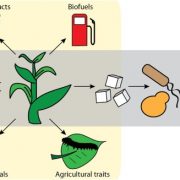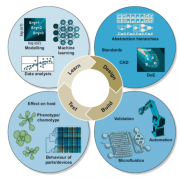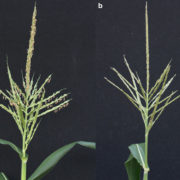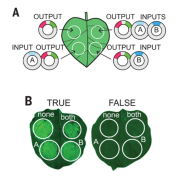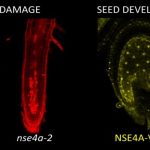Interviews with Synthetic Biologists: Kevin Chen, hyasynth
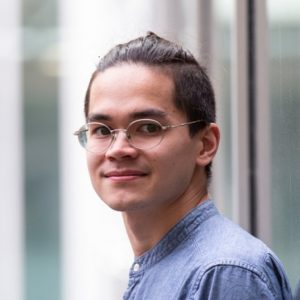 Synthetic biology is a set of tools, a way of thinking, the integration of engineering principles into biological sciences, and potentially the biggest opportunity for advances in plant sciences since PCR. Yet many struggle to define it, and fewer still grasp its full potential.
Synthetic biology is a set of tools, a way of thinking, the integration of engineering principles into biological sciences, and potentially the biggest opportunity for advances in plant sciences since PCR. Yet many struggle to define it, and fewer still grasp its full potential.
We have conducted a set of video interviews with leaders in the field of plant synthetic biology, in both academic and industrial areas.
In the eighth of this series Interviews with Synthetic Biologists, Mary Williams, Features Editor of The Plant Cell, interviews Kevin Chen, CEO of hyasynth.
I had the chance to chat with Kevin Chen, CEO of hyasynth, a start-up synthetic biology company based in Montréal, Canada, that is working to produce cannabinoids in yeast for medicinal and other uses. Kevin studied Biochemistry at Queen’s University, Ontario, Canada, and founded hyasynth shortly after he graduated. We talked about how hyasynth was founded, its goals, and how start-up accelerators like RebelBio can support young entrepreneurs.
Tell us about hyasynth
At hyasynth we’re focused on engineering strains of yeast that produce the same active compounds as the cannabis plant does.
It’s about importing the pathway … to create a new supply chain for the cannabinoids that can actually be produced at full FDA GMP requirements and also really huge scales so you can look at bigger health product opportunities that exist, and globalize, and shift cannabis from people with greenhouses to being more of an industrial scale … Something you can buy off the shelf that looks more like aspirin.
If CBD (cannabidiol) becomes the best thing for migraines, then everyone is going to have it in their bathroom cabinet, and we have to find a way to make that happen, and right now it doesn’t look like plants are going to be able to keep up.
What led you down the path of founding a start-up company?
It was inspired a lot by my experience at the iGEM competition, the bioengineering design competition. I got to work with ten other Queens University biotechnology and chemical engineering students over the summer, and we designed these crazy bioengineering projects. It’s a four-month long experience where you work super hard try to achieve something and raise your own money and spend your own money, and hopefully you get a gold medal at the end (and both years I did it we got gold medals!).
It did create kind of this idea – the way you do science there, we’re trying to solve this problem, develop something really cool, taking into account all the different social aspects of it as well, and these practical components, and it’s this really nice, all-encompassing field that I fell in love with.
How did you start to develop your company?
It was the first program of RebelBio, which is this startup accelerator program, and it was the first of its kind that was really focusing on synthetic biology as their investment angle and focus. We managed to get into the first cohort of that, even though we only had just an idea at the time, but we had a really solid team. That’s how we got our start. And from there things kept moving faster and faster and we were able to raise more money after we did the program. Now we’ve raised twelve million dollars to date, which is pretty exciting, we’re quite proud of that … and we’re able to get a lot of science done.
It’s a change in perspective, from an investment standpoint and also from a personal life standpoint. Going through ten years of PhD and postdoc, or maybe 15 years of doing these things and then still note being able to find a really great job… These ideas of young software CEOs, the idea of starting a company when you’re younger starts to makes more sense.
Combine that with the ideas of DNA synthesis and sequencing becoming so easy that you don’t need a PhD to clone a yeast that does these kinds of things. All of these things combine to create a nice opportunity and set a nice picture of starting companies a lot earlier and moving a lot faster in this sort of industry.
How does a start-up incubator work?
It’s meant to be this four month grind where you’re not given really enough money to take your time, you’re supposed to execute things superfast. The program itself is geared more towards first time entrepreneurs, and scientists who want to become entrepreneurs.
They provide a lot of mentorship and a lot of connections to help you get started. You don’t need an MBA to get into these things. In fact, maybe it’s better if you don’t, because it should be your own passion and energy and the energy that they give you and create in the program that will drive you to achieve really interesting things.
They provide mentorship and answers to all your questions, like how to raise money and how to develop a product, how to think about which contacts you need to make. That’s typically how these things work.
It depends on which one you’re looking at, but a lot of times they look at first-time entrepreneurs who have the tech background but need the business side of things. The investment firms that run these things are able to help a lot with the business stuff but not the science stuff and so that’s where they see the opportunities to fund these super early companies and these really great scientists, at this stage, and then push it to the next level.
Do you have advice for scientists who want to explore industry or entrepreneurship?
There’s a whole bunch of different things that you can do.
Checking out the start-up scene is good, just because by looking through the different programs and the companies coming out of them and who’s running them, you’ll see a much different profile compared to if you scroll through “who works at J&J” on LinkedIn. You’ll start to see different kinds of opportunities, and think more practically about what kind of experience you want to have, and what you want to build next.
The first think I did after my undergrad degree was work for another start-up, which is how I got connections to the RebelBio program. That opened the doors as well as far as what it’s like to work for a start-up, and what you can do with that kind of opportunity.
You want to get yourself out of this frame of mind where there’s industry or there’s academia. We’re doing this start-up thing where we have to deliver on really cool stuff and make things, but we’re small enough that we don’t have this hierarchy above us of some sort typical of industry.
So I would suggest a few things – the things that I did basically. See if you can find an opportunity to work at a start-up, that will give some insight into what that actually feels like. Maybe you’ll love it, maybe you won’t. Some start-ups are great and some are horrible.
The other community that’s really interesting that helped up get started also was the DIYbio or Biohacker community. There’s quite a few companies now that have come out of these – scientists who get together who aren’t that interested in being part of academia, and are always on the lookout for new ways to do their science or start companies. There are opportunities there to explore and meet new people.
There are plenty of events for start-ups also that you can hang around to see what its like and learn about more about who’s out there and what people are like in that area. That’s what I would suggest. (Kevin also later suggested applying for accelerator programs like that of RebelBio, which has a submission deadling of July 1.)
What does the future look like for hyasynth?
First of all we’re going to get really good at solving a lot of interesting biology problems, and then we’re going to develop a lot of really interesting products, and we’re going to find ways to make a lot of money (hopefully). That’s the plan at least.
The cannabis industry is going to be huge, we could easily spend the next twenty or thirty or hundred years continuing to build stuff in this industry, to build new and better products that target specific diseases, or products that aren’t even cannabinoids but are related and can be interesting products. We want to keep exploring and see how this company can grow and become a really big player in this space.
There’s so much to be done, it’s hard to find a real focus. You come up with new ideas every day, and keep them in a box somewhere and come back to them; there’s so much more to be done there.
I’m excited for the days when we start to flip on the really giant reactors that are going to produce the global supplies. To get to that stage is going to be a full, complete timeline for me. It’s not too far off now, everything is looking good.
Previously in this series:
- Steven Burgess interviews Professor Jennifer Nemhauser, University of Washington.
- Steven Burgess interviews Michael Mendez, Renew Biopharma.
- Steven Burgess interviews Matthew Mattozzi, Conagen Inc.
- Jenna Gallegos interviews Tobias Erb, Max Planck Institute for Terrestrial Microbiology in Marburg
- Jenna Gallegos interviews Guillaume Barbier, Joyne Bio.
- Jeanna Gallegos interviews Karsten Temme
- Henrik Toft Simonsen interviews Paul South
Stay tuned for more in this series of Interviews with Synthetic Biologists.


